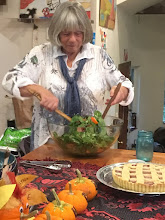My recipe box is made of cedar and sized to hold 3"x5" cards. On the cover is written, in script, "recipes," and in the upper left corner, almost faded, "Yosemite National Park." This box was a gift from Ela when he was but a little, little boy and spent a vacation at Yosemite with his dad and stepfamily. Pieces of frayed blue cardboard divide the box into sections with my handwritten categories: "Desserts" (first), "Bread," "Main Dishes," "Other." Recipes are stained, blotted, blurred, torn. They are written on the backs of things: a shopping list, a grocery receipt, some unknown person's prescription (July 1971), a photocopied poem by James Whitcomb Riley, a yellow scratchpad paper from Leo. M. Philpott Co. ( Seattle, Spokane, Portland—equipment and supplies for contractors). Recipes are written on heavy brown paper; tissue-paper-thin, beige paper, on both sides, with the ink showing through; lined notebook paper; colored 3"x5" cards (yellow, dark pink, white, blue). They were emailed ("Re: Re [2]: Cassatta?"), quickly jotted down from the radio, torn from cookbooks, magazines, newspapers, and cream cheese and phyllo cartons. Some cards are just notes: "Use plump soft raisins in cooking: pour boiling water over raisins and let them stand; then drain them well. Or place raisins in a sieve and steam them over boiling water." "Separate eggs by passing the yolk from one half of the broken shell to the other until all the white has drained into the bowl. Or do it the way the French do: pour the egg into your outstretched fingers and hold onto the yolk while the white drips through your fingers."
To open this box is to let loose not only all the odors of a kitchen in use but also the whole chronology of my cooking life: my student days, my hippy sojourn, my mountain living vegetarianism, the return to eating meat. From this box fly, on the odorous wings of recipes, memories of childhood and a flash of scenes from potlucks, dinner parties, and picnics. From it swarms a crowd of faces of family, friends, and cooks of all calibers and levels of passion. Most of all, what pours out when I open my recipe box is stories.
For this and the next six posts I'll tell some of the stories associated with recipes in my recipe box. The first is about a cake that, by family lore, is called the horrible cake.
Family legend has it that my mother first made this cake when my brother, Lee, the youngest of five children and the only boy, was very little. He wasn't sure he liked it. My father said, mockingly, "Oh, it's a horrible cake," to discourage Lee from eating any (so there would be more for him, of course). From that time on, the apple cake has been known as the "horrible cake." I don't know whether Lee understood the subterfuge at the time, but certainly now he likes horrible cake as well as the rest of us.
Next week: "A Box of Stories (2): September 11, 2001, in Sweden"
DAD'S HORRIBLE CAKE (Apple cake)
serves: 12
I cup cooking oil
2 cups sugar
2 cups sugar
3 eggs
2-3 apples
3 cups flour
1 teaspoon salt
1 teaspoon baking soda
2 teaspoons vanilla
Preparation
Grease 2 9" cake pans. Beat the eggs. Chop the apples. To prevent them from browning, put them in a bowl of cold water with the juice of about half a lemon. Do not preheat the oven.
To make
Mix together the oil, sugar, and beaten eggs. Add the chopped apples. Into this mixture sift the flour, salt, and baking soda. Add the vanilla. Pour the batter into the prepared pan and put it in a cold oven. Turn the temperature to 325º and bake 45 minutes, or until the cake tests done.
Easy caramel frosting
Though my mother served this cake without any frosting, and it's very good that way, the following is a delicious addition.
Ingredients
3 tablespoons butter
4 1/2 tablespoons milk
3/4 cup brown sugar, packed
1 1/2 cups confectioner's sugar
3/4 teaspoon vanilla
To make
Melt butter over medium heat. Mix in milk and brown sugar and boil vigorously 1 minute. Remove from heat and beat in half the confectioner's sugar. Let the mixture cool slightly, then beat in remaining confectioner's sugar and vanilla. Add more milk, if necessary, to achieve a spreadable consistency.




No comments:
Post a Comment